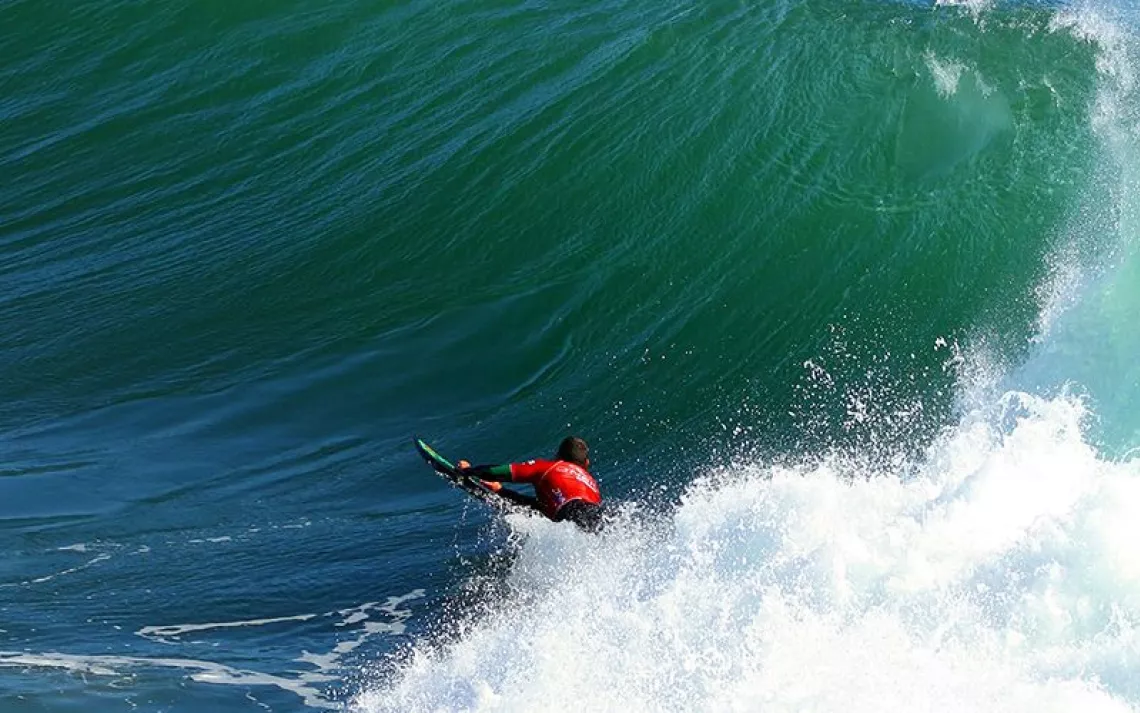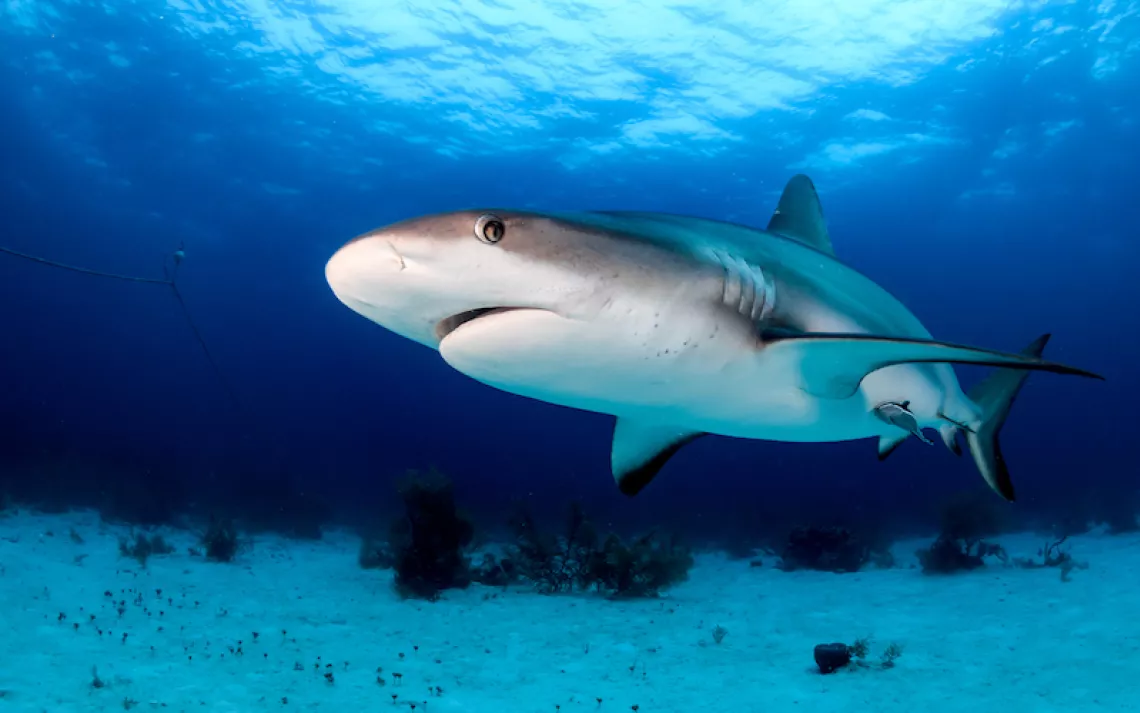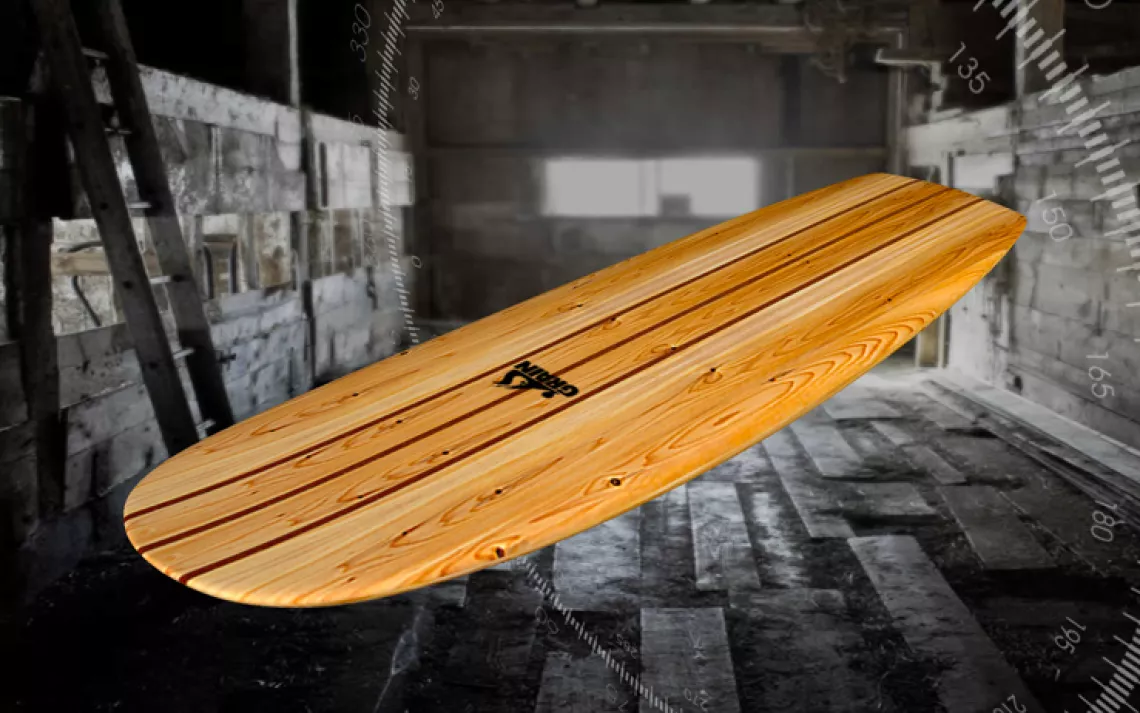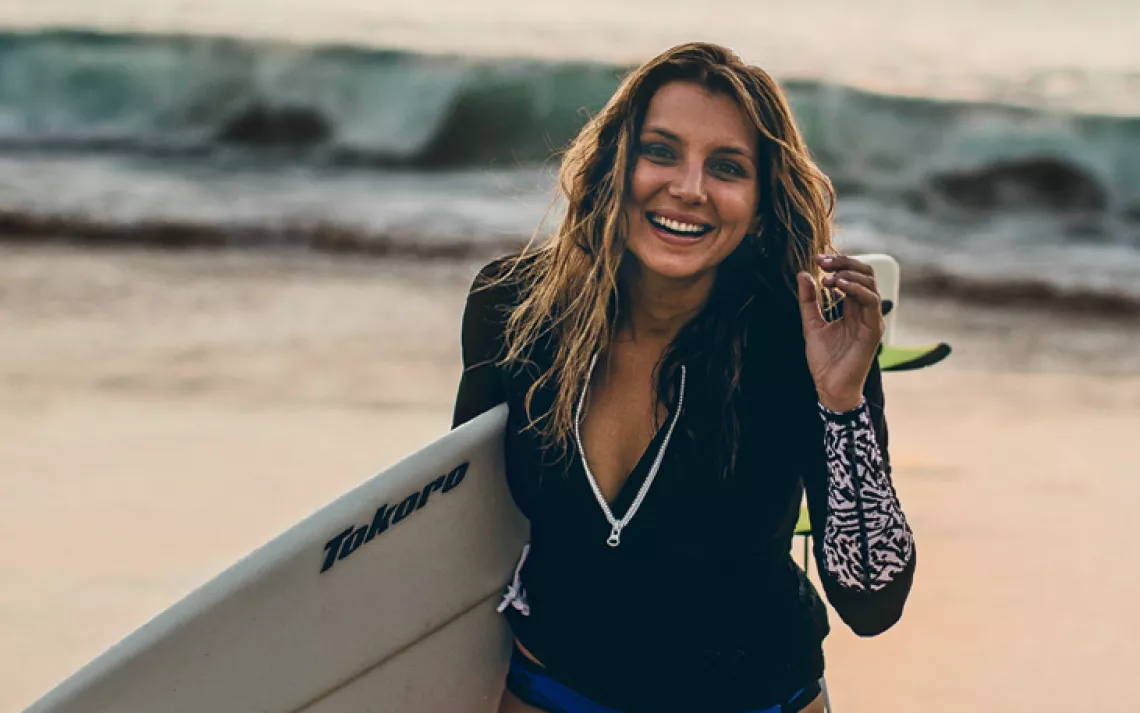This Athlete Is Carving a Path for Women Surfers
Big-wave surfer Bianca Valenti campaigns for gender equality
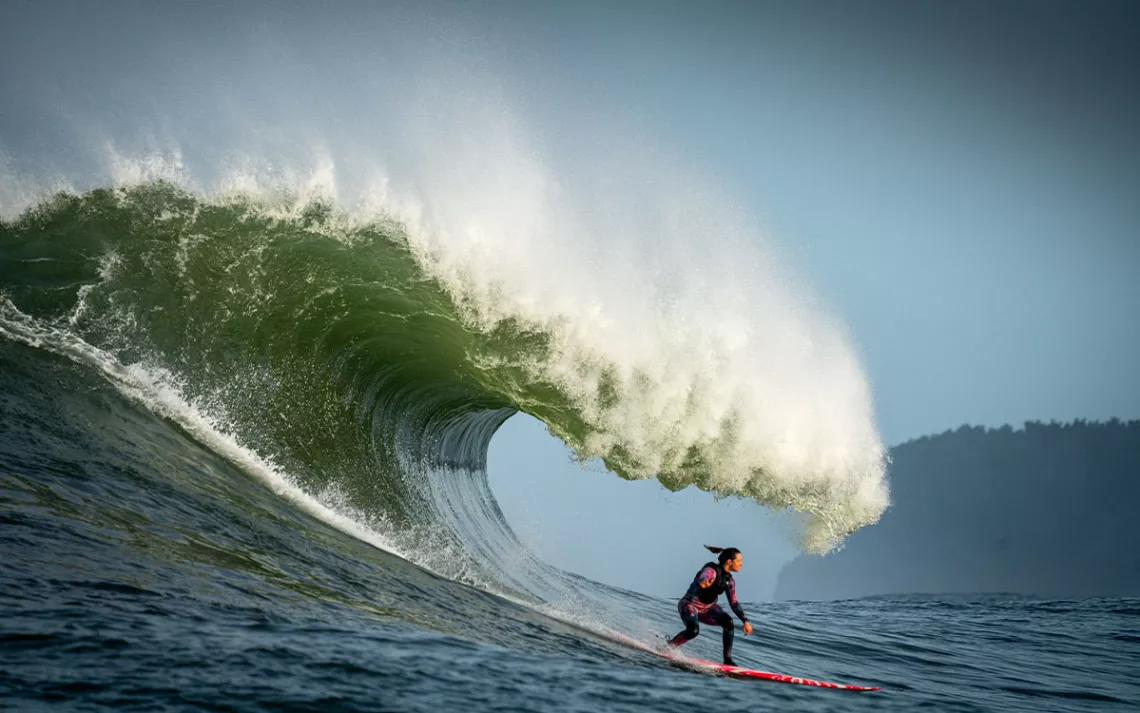
Bianca Valenti rides a wave at Mavericks in 2018. | Photo by Katie Zacarian
At the westernmost point of San Francisco, sprawling dunes divide the hilly, multicolored city from one of Northern California’s wildest surf spots: Ocean Beach. The four-mile beach break is lined with graffiti-printed seawalls and punctuated by signs warning of dangerous rip currents, known for sweeping swimmers out to sea.
On a crisp March morning, world-renowned surfer Bianca Valenti—who lives just a few blocks away—checks the waves, a hot-pink surfboard tucked under her arm. Her dog, Chichi, whom she adopted on a recent surf trip to Mexico, trails dutifully at her feet.
Valenti is petite—just five foot five—but undoubtedly strong, as she’s proved time and time again. She is known for regularly surfing 20-foot waves—and occasional 50-foot monsters. It’s helped to make her a pivotal force for gender equality in the male-dominated world of surfing.
As ravenous as Ocean Beach is this March day, it’s tame relative to Mavericks, the famous surf break just 30 minutes south. Mavericks, where winter storms routinely bring waves over 25 feet, has been the focus of Valenti’s campaign for women’s right to participate in big-wave surf competitions. Valenti surfs both breaks regularly, despite nearly losing her life at Ocean Beach in the early years of her surfing career.
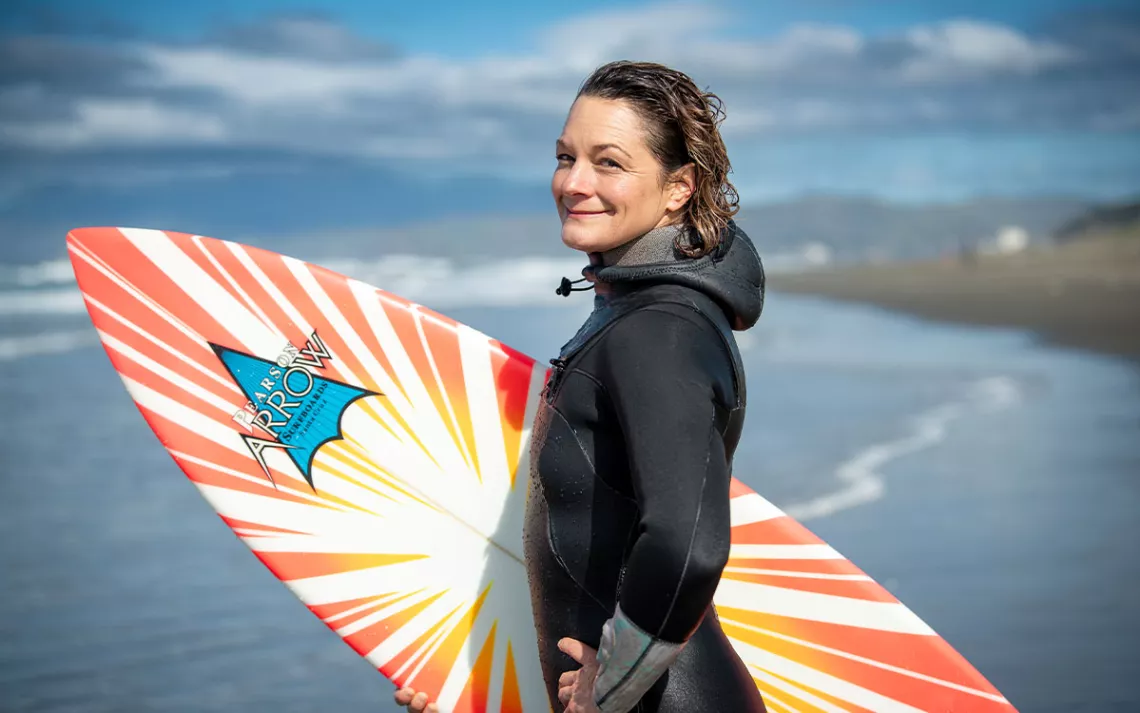
Bianca Valenti takes a moment to check the waves at Ocean Beach in San Francisco. | Photo by Nikki Kahn
Valenti caught her first wave on a boogie board at age seven in Orange County, California, where she grew up. Her mother offered to buy her a real surfboard but set a price cap at $75. After scavenging the local surf shops, Valenti found only one that fit her budget, a hard-top board covered in skulls and crossbones—“way too scary,” she says, though it's hard to imagine anything scaring her, even at age seven. But the surf shop cleaned up the board, ridding it of death-themed decorations, and sent the girl who would become one of the world’s best big-wave surfers on her way. New board in hand, Valenti went with her mom to Doheny State Beach at Dana Point, a local beginner’s surf break. Her mom planted a chair at the edge of the water. “Don’t make me come rescue you,” she said.
That week, Valenti pasted a 1992 Surf World Championship poster on the wall of her childhood bedroom that featured the surf legend Kelly Slater. “I want to be that,” she said. “I want to be the best surfer.”
In her teenage years, however, she faced the grim reality that many female athletes face, that girls don’t have equal opportunities to boys'. “That pissed me off,” she says.
The adults in Valenti’s life advised her against what she was inevitably going to do—try to become a professional surfer. “[Surfers] don’t make any money,” she remembers people saying. They urged her to pursue a different career path, or at least a different sport. But “none of that clicked,” Valenti says.
At the University of California, Santa Barbara, she became captain of the surf team and spent more time thinking about surfing than studying. If she was going to make it on the World Surf League (WSL) tour that qualifies athletes to compete at the highest level, she’d need sponsors. That required her to have a “model look,” which Valenti says she didn’t have. She just wanted to surf—not model. It was a double standard that didn’t seem to apply to male surfers.
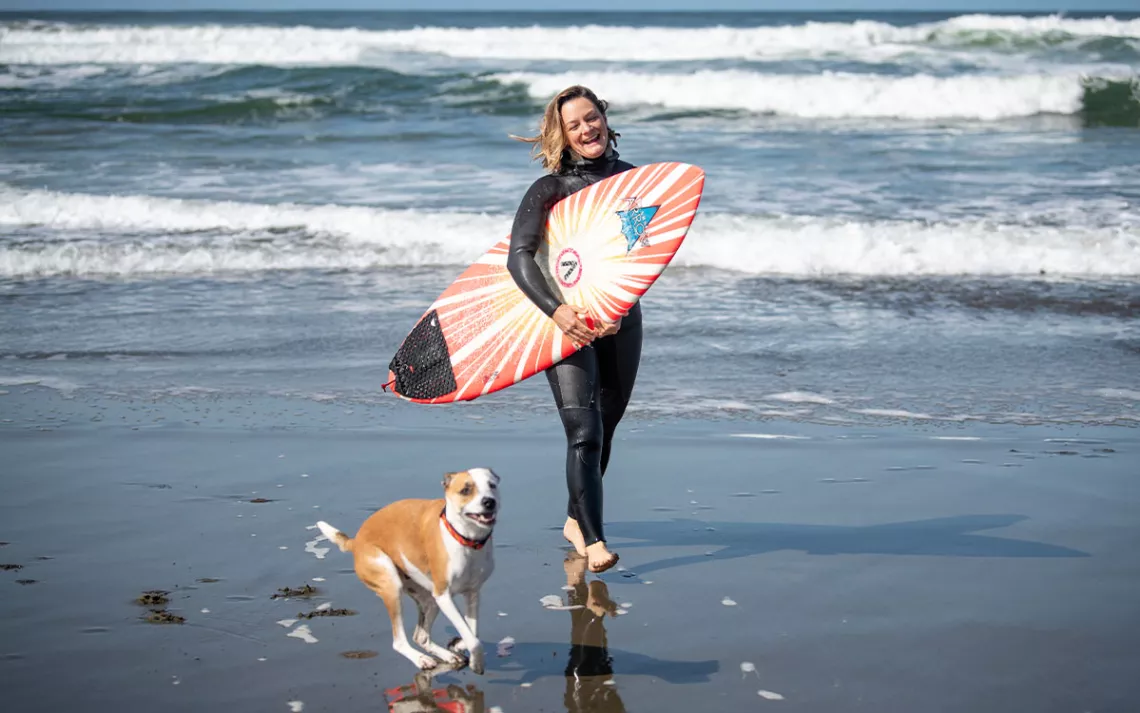
Bianca Valenti and Chichi enjoy the morning at Ocean Beach. | Photo by Nikki Kahn
During her college years, Valenti surfed everywhere she could. “Campus Point, Devereux, Sands, Depression, Sandspit, Rincon, El Capitan, Silver Strand,” she recounts, with an air of nostalgia. Some of the spots were “really hardcore,” with heavy, deathly waves. Unable to find anyone skilled—or crazy—enough to join, “I would just go by myself,” she says.
One morning while Valenti was in college, she drove up the California coast to San Francisco’s Ocean Beach on a hunt for waves. The winds that day were blowing just right, she says; dark-green waves rose to their peak, then peeled to the left and right into perfect A-frames. “Oh my gosh,” she said to her surf buddy. “We just struck gold.” It was a surfer’s paradise, right in the center of the city.
But, she tells me, she forgot rule number one for Ocean Beach: “It’s always bigger than it looks.”
Foolishly enthused, Valenti flew into the surf, diving below the whitewater. She looked up at a wave surging toward her, growing larger as it got closer. “I had never seen a wave that big,” she says. “It was the size of a two-story house.”
Quickly, Valenti understood she was out of her depth. Her friend, paddling next to her, looked at the wave, then back at her and said, “Well, see you on the other side.” Unsure how to react, Valenti tipped the nose of her board under the wave, attempting to dive through it. But the water was heavy. “Immediately, the board ripped out of my hands,” she says. Her body contorted, flipping and twisting, “completely rag-dolled. . . . It was the most violent beating I’d experienced.” Unsure which way was up, Valenti opened her eyes but only saw darkness, as she felt her feet pressing against the sand. She was physically depleted but able to manage the couple strokes she needed to get to the surface of the water and gasp for air. “If there’s another wave, I’m gonna die,” she thought. “It’s just a fact.” Luckily, that second wave didn’t come.
Afterward, she was haunted by those perfect waves that had almost killed her. She wanted to surf them, desperately. But after what happened, she knew she needed to put in the training. “That was the moment I decided that's what I wanted to do. And I never looked back.”
Valenti doubled down on her out-of-water training, practicing free diving and breath work and learning to manage her fear. She’s learned to love surfing Ocean Beach but acknowledges that in order to do so, “you have to be a bit of a glutton for punishment.”
Within a few years, she was ready to take on Mavericks.
The waves at Mavericks “break with enough energy to light up San Francisco,” Valenti says. She had to convince a local surfboard shaper to let her buy a board from him. He resisted, claiming that he didn’t want her to die. But at that point in her career, Valenti was more qualified than many of the men who routinely surfed there; warnings were not what she needed. She had to learn to look past the mind games, and, often, the sexism that came with being the only woman in a lineup of male surfing legends. Surfing Mavericks was like entering “a pack of lions,” Valenti says. “People don’t take turns.” She learned to channel her power animal, the “killer bee,” as she paddled into waves—a method she had learned from working with a sports psychologist. Like a killer bee, she wanted to send the message that “I'm not going to kill you, but you don't want to mess with me because I could kill you.”
Valenti became a known character at Mavericks, where she continually surfed bigger and bigger waves. But one major obstacle still stood in her way: women’s ability to compete and their right to equal pay. To this day, there’s been 10 Mavericks surf competitions—none of which have included women.
In 2014, Valenti and the seven other best female big-wave surfers were invited to Nelscott Reef in Oregon, one of six stops on the then-men’s-only WSL Big Wave World Tour. The experience of competing and surfing with other women was awe-inspiring for Valenti, who won the competition despite not being fully healed from a torn medial collateral ligament in her knee. Afterward, Valenti was fired up, ready to campaign for women’s rights to participate in all six of the tour’s stops.
Valenti’s next fight—naturally—was Mavericks, where she was already a regular. To her, it only made sense that she should be able to compete there. But Valenti “had no idea the fight that they were about to start,” she says.
The next contest at Mavericks, scheduled for the winter of 2015, was designed to host 24 surfers—all male. In 2016, Valenti and her crew of other female big-waves surfers—among them Paige Alms, Andrea Moller, and Keala Kennelly—founded the Committee for Equity in Women’s Surfing and outlined their demands for Mavericks: that at least half of the surfers be women, and that men and women should earn equal cash prizes.
The demands had some powerful muscle behind them. Since any contest at Mavericks needs approval from the California Coastal Commission, a state agency, barring women could be a form of gender discrimination, something explicitly banned by the California Coastal Act of 1976. The commission approved the permit for Mavericks 2017-18 competition, with the requirement that women be included.
Surf conditions didn’t cooperate that year, however, and the contest never happened. It has now been five years since Valenti won women’s right to compete at Mavericks, and the competition still hasn’t happened, mostly due to a lack of funding. Nevertheless, at 38 years old, Valenti is still charging, surfing the world’s heaviest waves, including in competition. And most recently, in December 2019, women competed alongside men at Jaws, an iconic break on the north shore of Maui, where they earned equal cash prizes.
But Valenti’s uncertain if the competition she’s fought so hard for will happen in her surfing lifetime. “I’m hopeful that Mavericks will happen for the next generation,” she says. “That’s really what gets me inspired these days.” Finally, men are cheering for women in the water.
Despite the positive change Valenti has witnessed, she still wants to see more women in the water, particularly at expert-level surf breaks. To this day, nearly twice as many men than women make it to the top level of WSL competition. And in competition, contest organizers often prioritize running the men's heats when the conditions are the best and the waves are biggest.
For now, the surf competition at Mavericks has been replaced by a video performance competition, in which surfers submit their best filmed wave. In 2023, Valenti won three out of the three awards available to women: Biggest Wave, Ride of the Year, and Performer of the Year. In her video, she’s crouched low on her board, flying down the blue face of a wave, as an avalanche of water falls over her head.
In recent years, Valenti has been mentoring a 17-year-old surfer, Zoe Chait, with whom she regularly surfs at Ocean Beach. When Valenti watched Chait surf her first wave at Mavericks, she remembers "feeling [her] heart burst open.” Valenti has loved being “the modern elder,” as she puts it. “I never had access to anyone like that when I was a kid.”
 The Magazine of The Sierra Club
The Magazine of The Sierra Club
